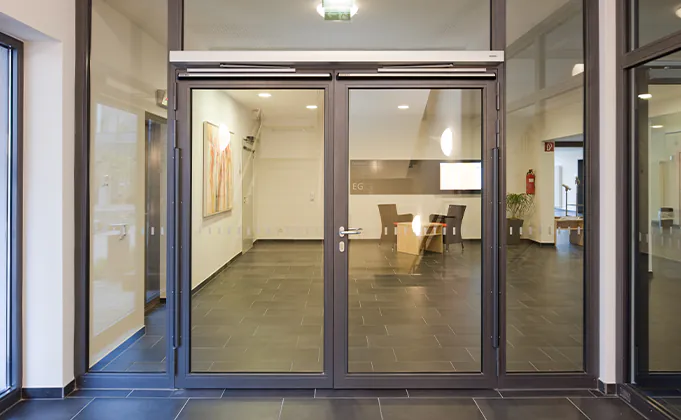Key Takeaways
- Automatic doors are a staple in modern architecture, providing accessibility and convenience.
- Regular maintenance of automatic doors is crucial to ensure efficient operation and longevity.
- Innovative technology is poised to further enhance the functionality and efficiency of automatic door systems.
Table of Contents
- Importance of Automatic Doors in Commercial Spaces
- The Mechanics Behind Automatic Doors
- Comparison of Manual and Automatic Doors
- Safety Measures and Industry Standards
- Choosing the Right Automatic Door Service
- The Environmental Impact of Automatic Doors
- The Role of Professional Services
Importance of Automatic Doors in Commercial Spaces
Offering more than mere convenience, automatic doors have become integral to the architecture of commercial spaces, serving as a beacon of modern functionality and inclusive design. They provide seamless access to individuals from all walks of life, reflecting a building’s commitment to accessibility for those with reduced mobility, the busy parent managing a stroller, or a delivery person handling cumbersome packages. What’s more, in today’s health-conscious society, the reduced touchpoints of automatic doors contribute significantly to public health measures by limiting the spread of germs in high-traffic areas such as airports, hospitals, and shopping centers.
The Mechanics Behind Automatic Doors
Automatic doors represent a marvel of modern engineering, combining sophisticated sensor technology with motorized systems to facilitate the smooth transit of people. These doors operate via intricately designed sensors that detect various stimuli, such as motion or proximity, activating a control mechanism that signals to the motor when to glide the door open or securely close gently. The longevity and functionality of these complex systems are preserved through diligent automatic door service, which plays a pivotal role in ensuring that the mechanisms remain in prime condition. Professionals specializing in these services carry out necessary repairs and provide preventative maintenance to circumvent any potential malfunctions that could arise unexpectedly and cause disruptions or jeopardize user safety.
Comparison of Manual and Automatic Gates
Deciding between manual and automatic gates for a facility involves delving into a cost-benefit analysis that spans beyond the initial outlay. While automatic door installations may command a higher upfront cost, their advantages are multifaceted. They offer unrivaled accessibility, can reduce heating and cooling losses, thereby providing energy savings over time, and bolster a business’s public image as forward-thinking and user-friendly. Conversely, while initially less expensive and simpler in design, manual doors need more automation sophistication and can be a barrier to ease of access and the provision of touch-free environments that modern users increasingly expect and appreciate.
Safety Measures and Industry Standards
Ensuring the safe operation of automatic doors is paramount. Reliable door service providers diligently adhere to stringent industry safety standards, including ADA guidelines mandating door systems to accommodate users with disabilities. Beyond statutory obligations, there are best practices, such as incorporating time-delayed retraction and motion sensors to prevent entrapment and collision – all of which make automatic doors convenient and safe. Regular inspections and safety audits are indispensable components of responsible maintenance, providing facility operators and patrons peace of mind.
Choosing the Right Automatic Door Service
Identifying and collaborating with the right service provider is crucial for ensuring the optimal performance of automatic door installations. Selection should be based on the provider’s proven track record, customer needs responsiveness, and talent for providing innovative, tailored solutions. Furthermore, assessing service offerings through the lens of door performance and reliability is vital, considering factors such as energy efficiency, technical support, warranty provisions, and user feedback. This due diligence helps safeguard the investment and guarantees the functionality and durability of the automatic door systems.
The Environmental Impact of Automatic Doors
In the current era, where ecological considerations are paramount, the environmental benefits of automatic doors are precious. These systems are often designed to be energy-efficient, regulating indoor climate by preventing excessive air exchange and significantly reducing energy loads for heating and cooling. This efficiency not only supports the sustainability goals of many businesses by mitigating their environmental footprint but also translates into measurable cost savings on energy bills, creating a win-win scenario for both the planet and the pocketbook.
The Role of Professional Services
The successful integration of automatic door systems rests squarely on the shoulders of proficient service providers. Recognizing the critical nature of their role, these professionals bring a wealth of knowledge and experience that is indispensable in both the installation and maintenance phases. Their insights guide stakeholders through decision-making, demystifying technical specifications, and translating industry jargon into actionable understanding. Through their dedication and skill, they ensure that these innovative systems provide consistent, reliable service across various applications.























